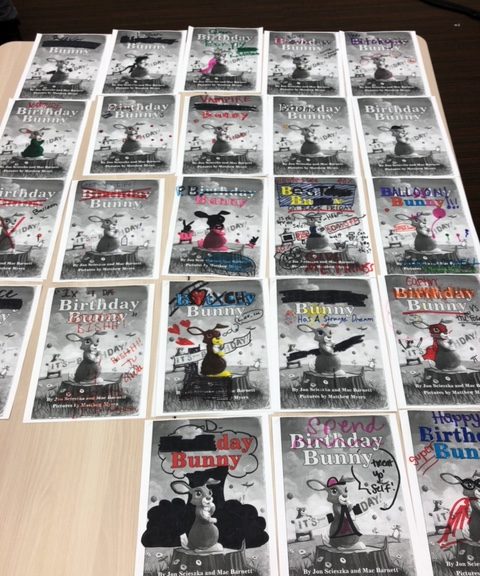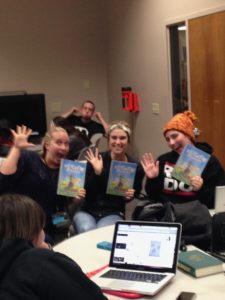
Weeks 14-16: Make Cycle 7 (Remix & Reflect)
 Make Cycle 7: Remix & Reflect
Make Cycle 7: Remix & Reflect
Nov 29-final’s week
For this final make cycle, we’ll start by thinking about stories, and we’ll remix stories with a text in common: Battle Bunny! We’ll look at how Barnett and Scieszka remixed Birthday Bunny to create Battle Bunny and then try out our own versions. A cool idea you can do with students is to gather old children’s books (Little Golden Books are great for this) and have them remix and rewrite the stories. You can also print out the pdf of The Birthday Bunny and have students create their own versions. On their website, they even have a place for sharing your students’ creations. This activity can also help you talk about the difference between revision (changing the text significantly by rewriting, extending, reorganizing, cutting) versus editing (polishing and checking for typos). You can also talk about choices that the authors make in the two versions, elements of stories, remix culture, etc.
After watching Mac Barnett’s TED talk, and playing with our remixes of Battle Bunny, we’ll finish up Reading in the Wild and consider your reading preferences. And finally, you’ll write a reflection focused on what you’ve learned about the teaching of reading and yourself as a reader, ending with a manifesto: what you believe about the teaching of reading.
In a nutshell:
- By Wednesday, Dec 1: respond to a prompt after watching Mac Barnett’s TED talk.
- By Sunday, Dec 5: respond to prompt and remix Battle Bunny
- By Friday, Dec 10: respond to prompt about Miller Chapter 5
- By Wednesday, Dec 15 (final’s week): Reflection & Manifesto due in shared Google Doc (Not Currents). PLEASE PLEASE PLEASE NOTE my email for google sharing (slightly different than my faculty email): kjaxon@mail.csuchico.edu
Nov 29-Dec 15:
By Wednesday, Dec 1:
- I want to introduce you to Mac Barnett, one of the authors of Battle Bunny and the author of many other fabulous children’s books (Extra Yarn is one of my favorites). Watch the TED talk by Mac Barnett and write a response that shares your take-aways from his talk (watch all the way through so you don’t miss meeting Niko ;-)). What insights do you glean from his description of storytelling and why we tell and read stories? Let’s take a pass at answering the big question of the class: why read? how can we make reading magical and not a chore?
Post in Currents: Barnett TED talk
By Sunday, Dec 5: two part prompt
- Read Battle Bunny (<—link to whole book) and then check out this resource for educators. Choose ONE of the “Postreading Discussion Questions” from the resource (also shared directly below) and respond to it:
- Who is the main character of Battle Bunny—Bunny, or Alex? Use the story to support your answer.
- Who is/are the real authors of Battle Bunny—Alex, or Jon Scieszka and Mac Barnett?
- How was the story of Birthday Bunny structured before Alex made his changes (in particular, what was the climax)? What is the structure and climax after Alex makes changes? Did Alex change the structure, or did he just change the outcome?
- What are some words that describe the story setting before and after Alex made his changes?
- What are some words that describe the Bunny character in Birthday Bunny? What about in Battle Bunny?
- What are some words that describe Alex? (Possibilities: smart, funny, creative, expressive, bored, entertaining . . . ) How do you know? Answer using examples from the story. Do any of these words describe you?
- Why do you think there are so many books for kids that are way too sappy? What are the grown-ups who create sappy books trying to do?
- What are some other stories Alex could have transformed Birthday Bunny into, besides Battle Bunny?
- What are some other books you wish you could transform the way Alex did? What would you turn them into?
- Help students find other works by the authors and illustrator of Battle Bunny. What do you notice that’s similar about their titles? What’s different?

2. Then, make your own version of The Birthday Bunny and share with us. I can think of a few ways to do this:
- Here is the link to the pdf of The Birthday Bunny. Print 1-2 pages of the book (the cover or perhaps a page or two inside the story) and get out your markers and revise. It will take some printer ink, so I would only do the cover and/or a couple of pages of the text. Once you’ve remixed/revised, then take a picture of your creation and upload the image to your post/response to one of the questions above.
- Use Storyjumper to upload your own revision of Birthday Bunny. Create your own drawing or a different narration.
- You could use a digital platform or app to draw on the pdf version of Birthday Bunny. Maybe some of you are crazy good at Photoshop or Procreate on the iPad…
- OR, if you have a book you’d like to try this out with (perhaps a Little Golden Book? or other children’s book?), then go ahead and remix that and share some images of your remix with us. 😉
Post in Currents: Battle Bunny and Miller 5
By Friday, Dec 10: Miller chapter 5
 Chapter 5 focuses on reading preferences and how to think about both supporting and challenging reader preferences. Per usual, talk about what resonates with you in this chapter: what might you consider for your future classroom?
Chapter 5 focuses on reading preferences and how to think about both supporting and challenging reader preferences. Per usual, talk about what resonates with you in this chapter: what might you consider for your future classroom?
Then, what have you learned about yourself as a reader? What are your reading preferences and how will you continue to grow as a reader and a teacher of reading?
BTW: I mentioned Goodreads in the video update, which is a site that can help you keep track of your reading and reading plans. Highly recommend. Here is the link: https://www.goodreads.com/
Post in Currents: Battle Bunny and Miller 5
Final’s Week
By Wednesday, Dec 15: Reflection & Manifesto due (in shared Google Doc)
Reflection & Manifesto
*NOTE: This assignment will be shared in a Google Doc with me and not posted in Currents. Make sure I can comment and not simply view only. 😉
PLEASE PLEASE PLEASE NOTICE my email for google sharing (slightly different than my faculty email): kjaxon@mail.csuchico.edu
We’ll end the semester with a teaching reading manifesto and a reflection on what we’ve learned about the teaching of reading in our course. The manifesto has two sections:
1) a longer reflection on your work in the course (2-3 pages)
2) a bulleted list that is your manifesto: things you believe about the teaching of reading (the number of items on your list is up to you)
See the student examples below; I think they’ll be helpful.
You’ll start this assignment by reflecting on your work in the class: read through your Currents posts (like really; it will make you feel so good about all you’ve done in our class this semester), think about our Reading in the Wild conversations, the books you read, your makes–what have you learned about teaching reading, about your own reading habits, about students’ reading practices? What is challenging about teaching reading, what is surprising, what do you look forward to?
Then, turn to the creation of a bulleted list…your personal manifesto about teaching reading. Think of it as a “This I Believe About the Teaching of Reading…”
Here are some examples from previous semesters:
Leslie’s reflection and manifesto
Trevor’s reflection and manifesto
*NOTE: This assignment will be shared in a Google Doc with me and not posted in Currents. PLEASE PLEASE PLEASE NOTE my email for google sharing (slightly different than my faculty email): kjaxon@mail.csuchico.edu
 Instructions for sharing a Google Doc and setting to comment, not just view only:
Instructions for sharing a Google Doc and setting to comment, not just view only:
- Go to: http://www.csuchico.edu/google
- On left, click on Google Drive login
- May ask you to log in with Chico State portal ID/password
- Click on “New”: Choose Google Doc from the drop down menu under New
- Name file in upper left corner (click where it says “Untitled”). Use last name in title and Reflection. For example: Ramirez_Reflection_Engl341
- Click Share in upper right and share with: kjaxon@mail.csuchico.edu. Set it so I can comment or edit, not just view. I’ll get an email saying it is shared with me.
- THANK YOU!
You all have done beautiful work this semester! Grateful for your efforts in our course. Thrilled that y’all are thinking about a career in education. Take care. Kim